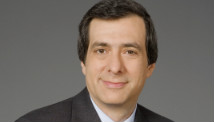LOS ANGELES (AP) — James Comisar is the first to acknowledge that more than a few have questioned his sanity for spending the better part of 25 years collecting everything from the costume George Reeves wore in the 1950s TV show “Superman” to the entire set of “The Tonight Show Starring Johnny Carson.”
Then there’s the pointy Spock ears Leonard Nimoy wore on “Star Trek” and the guns Tony Soprano used to rub out a mob rival in an episode of “The Sopranos.”
“Along the way people thought I was nuts in general for wanting to conserve Keith Partridge’s flared pants from ‘The Partridge Family,’” the good-natured former TV writer says of the 1970s sitcom as he ambles through rows of costumes, props and what have you from the beginnings of television to the present day.
“But they really thought I needed a psychological workup,” Comisar, 48, adds with a smile, “when they learned I was having museum curators take care of these pieces.”
A museum is exactly where he wants to put all 10,000 of his TV memorabilia items, everything from the hairpiece Carl Reiner wore on the 1950s TV variety program “Your Show of Shows” to the gun and badge Kiefer Sutherland flashed on “24″ a couple TV seasons ago.
Finding one that could accommodate his collection, which fills two sprawling, temperature-controlled warehouses, however, has sometimes been as hard as acquiring the boots Larry Hagman used to stomp around in when he was J.R. on “Dallas.” (The show’s production company finally coughed up a pair after plenty of pleading and cajoling.)
Comisar is one of many people who, after a lifetime of collecting, begin to realize that if they can’t find a permanent home for their artifacts those objects could easily end up on the trash heap of history. Or, just as bad as far as he’s concerned, in the hands of private collectors.
“Some of the biggest bidders for Hollywood memorabilia right now reside in mainland China and Dubai, and our history could leave this country forever,” says Comisar, who these days works as a broker and purchasing expert for memorabilia collectors.
What began as a TV-obsessed kid’s lark morphed into a full-fledged hobby when as a young man writing jokes for Howie Mandel and Joan Rivers, and punching up scripts for such producers as Norman Lear and Fred Silverman, Comisar began scouring studio back lots, looking for discarded stuff from the favorite shows of his childhood. From there it developed into a full-on obsession, dedicated to preserving the entire physical spectrum of television history.
“After a couple years of collecting, it became clear to me,” he says, “that it didn’t much matter what TV shows James watched in the early 1970s but which shows were the most iconic. In that way, I had sort of a curator’s perspective almost from the beginning.”
In the early days, collecting such stuff was easy for anyone with access to a studio back lot. Many items were simply thrown out or given away when shows ceased production. When studios did keep things they often rented them out for small fees, and if you lost or broke them you paid a small replacement fee. So Comisar began renting stuff right and left and promptly losing it, acquiring one of Herman Munster’s jackets that way.
These days almost everything has a price, although Comisar’s reputation as a serious collector has led some people to give him their stuff.
If he simply sold it all, he could probably retire as a millionaire several times over. Just last month someone paid $ 480,000 for a faded dress Judy Garland wore in the 1939 film “The Wizard of Oz.” What might Annette Funicello’s original Mickey Mouse Club jacket fetch?
He won’t even think about that.
“I’ve spent 25 years now reuniting these pieces, and I would be so sick if some day they were just broken up and sold to the highest bidder,” he says.
He, and every other serious collector of cool but somewhat oddball stuff, face two major obstacles, say museum curators: Finding a museum or university with the space to take their treasures and persuading deep-pocketed individuals who might bankroll the endeavor that there’s really any compelling reason to preserve something like Maxwell Smart’s shoephone.
“People hold television and popular culture so close to their hearts and embrace it so passionately,” says Dwight Bowers, curator of entertainment collections for the Smithsonian’s National Museum of American History, who calls Comisar’s collection very impressive. “But they don’t put it on the same platform as military history or political history.”
When the Smithsonian acquired Archie Bunker’s chair from the seminal TV comedy “All in the Family,” Bowers said, museum officials took plenty of flak from those offended that some sitcom prop was being placed down the hallway from the nation’s presidential artifacts.
The University of California, Santa Cruz, took similar heat when it accepted the Grateful Dead archives, 30 years of recordings, videos, papers, posters and other memorabilia gifted by the band, said university archivist Nicholas Meriwether.
“What I always graciously say is that if you leave the art and the music aside for one moment, whatever you think of it, what you can say is they are still a huge part of understanding the story of the 1960s and of understanding the nation’s counterculture,” says Meriwether.
Comisar sees his television collection serving the same purpose, tracing societal changes TV shows documented from the post-World War II years to the present.
The Academy of Television Arts and Sciences Foundation looked into establishing such a museum some years back, and Comisar’s collection came up at the time, said Karen Herman, curator of the foundation’s Archive of American Television.
Instead, the foundation settled on an online archive containing more than 3,000 hours of filmed oral history interviews with more than 700 people.
While the archive doesn’t have any of Mr. Spock’s ears, anyone with a computer can view and listen to an oral history from Spock himself, the actor Leonard Nimoy.
Comisar, meanwhile, believes he’s finally found the right site for a museum, in Phoenix, where he’s been lining up supporters. He estimates it will cost $ 35 million and several years to open the doors, but hopes to have a preview center in place by next year.
Mo Stein, a prominent architect who heads the Phoenix Community Alliance and is working with him, says one of the next steps will be finding a proper space for the collection.
But, really, why all the fuss over a place to save one of the suits Regis Philbin wore on “Who Wants to be a Millionaire”?
“In Shakespeare’s time, his work was considered pretty low art,” Comisar responds.
Oh, he’ll admit that “Mike and Molly,” the modern TV love story of a couple who fall for each other at Overeaters Anonymous, may never rank in the same category as “Romeo and Juliet.”
“But what about a show like ‘Star Trek’?” he asks.
Entertainment News Headlines – Yahoo! News
Title Post: A huge collection of odd TV stuff needs a home
Rating:
100%
based on 99998 ratings.
5 user reviews.
Author:
Thanks for visiting the blog, If any criticism and suggestions please leave a comment



